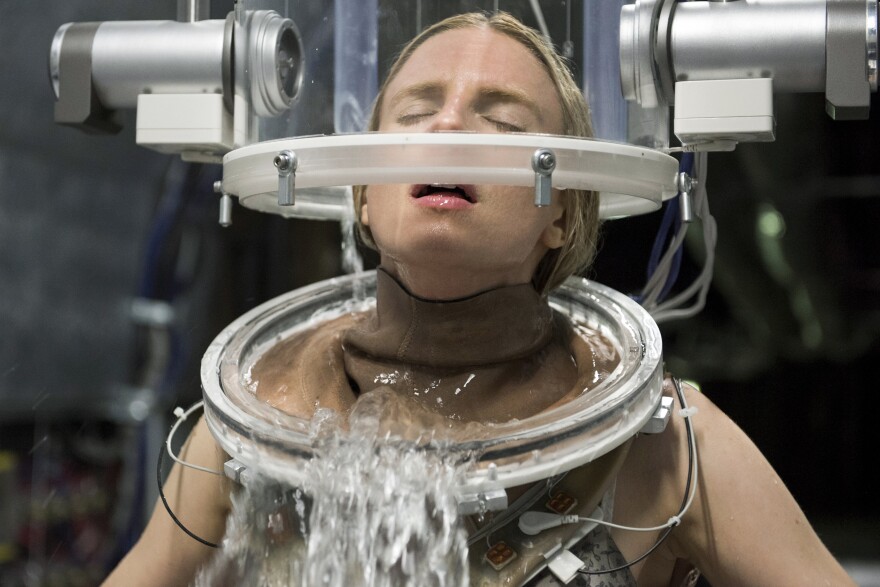If you've been watching Netflix's new series "The OA," the initial feelings of fascination and terror may by now be fading into more pragmatic questions about how the series was made.
For example, how did they film those horrific scenes where characters are strapped into a drowning machine? And what inspires Brit Marling to continually adopt dark roles?
To recap: "The OA" was co-created by Brit Marling and Zal Batmanglij. Prior to this they’d co-written the indie films “Sound of My Voice” and “The East,” in which Marling starred and Batmanglij directed. For "The OA," he is again in the director’s chair and she plays the lead — the enigmatic character called Prairie.
The two recently came into The Frame studios to talk with John Horn. You can hear and read a longer conversation about how they pitched the show and what they wanted to do with this here. Below are outtakes from that conversation that will make more sense for people who have seen "The OA."
Interview Highlights:
On filming the drowning scenes:
ZB: It wasn't that easy to go there. The guy brings people to death by drowning just their heads. He puts their heads in water. And that's a real apparatus that we designed. That's not CG [computer generated]. That's real. So Brit really held her breath. And now I'm like, "How did we do that? What were we thinking?" I think it really traumatized the crew. It was a scary thing to watch. I think the crew had a great deal of respect for Brit, but after that — you'd handled that with such grace. But it was really scary and I think that people kept getting sick that week. I don't think that was an accident. I think that people's bodies were hit because it's an intense thing. I think we watch movies and stories on TV and we think that these things are completely fictions, but they're not. The actors have to really go through a lot of these emotional spaces to experience them.
BM: I think also there's something about this story that felt like, in order to touch the heights and the light that it wanted to touch, you have to go with this young woman who has survived a great deal and touch the very center of the dark with her. It's because you go there that you can reach the places at the end of chapter five and all eight chapters that hopefully point to something bright and open and very hard to look at directly. Something you can almost only look at in the periphery because it has a mystical quality to it.
On how Brit Marling got into the mindset of Prairie:
BM: I felt very early on — and you hear this a lot as an actor — that if you can't point to very specific dark traumas within your life, you'll never be a great actor because you can't. You need to be able to draw on those things. I've always thought that was so funny because I've never used real-life experiences. I just use my imagination. The imagination is limitless. It's infinite. So if you spend enough time sitting in any one place and thinking about it and feeling it through in your whole body, you can really touch profound empathy for anything. I think that's why I love the craft of acting so much because the more I practice it, the more empathic I think I can become as a human being.
Certainly, I think Prairie's crisis of identity — all the different stages of self she goes through — I have felt that. I moved a lot as a kid, so I think that kind of itinerant childhood makes you realize right away that identity is a very ephemeral construct. Personality doesn't really exist. That largely you have a certain set of inputs you deal with every day — your work, your lover, your kids, your house. Because you have the same inputs, you generally give the same output. That appears as a consistent personality. But I think the moment things get off script or off book and something happens that's strange or unusual, you find yourself capable of strange or wild things. So I think that's what happens to Prairie. Her life takes her pretty dramatically off-book and she has to find out if she has the mettle to face that.
On the relationship between Zal as director and Brit as actor once shooting began:
ZB: It's funny because Brit and I write these projects together and we spend so much time, not only in writing it, but also in pre-production together. And then, Brit goes off to do the work of becoming Prairie and becoming this character. And it's quite lonely for me because I lose my partner. When we see each other again on set, she's not the same person. I can tell that she's someone different. One of the things that I really liked about doing this project is I liked who Prairie was. I liked who the OA is. So I didn't mind losing Brit to spend five months with her. She was an interesting person.
"The OA" is a Netflix Original Series. All episodes are streaming now.



